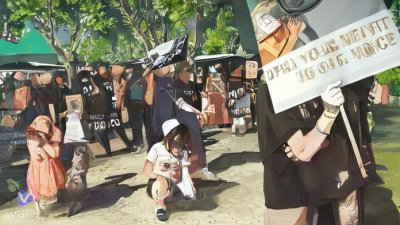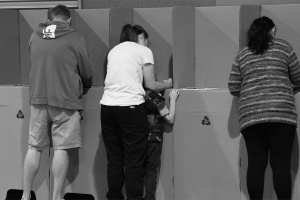[According to the World Watch 2024 Report, the Human Rights Issues still exist in Australia. The World still have concerns on Human Rights Issues in Australia] By Syed Atiq ul Hassan, Sydney Australia; 16 May 2024]
The World Watch 2024 Report has once again cast a spotlight on the enduring human rights issues within Australia. Despite its status as a developed nation, Australia finds itself among the hundred countries grappling with multifaceted challenges in upholding human rights standards. This 740-page report meticulously documents various facets of Australia’s human rights landscape, offering a roadmap for improvement across multiple sectors.
hundred countries grappling with multifaceted challenges in upholding human rights standards. This 740-page report meticulously documents various facets of Australia’s human rights landscape, offering a roadmap for improvement across multiple sectors.
Tirana Hassan, the Executive Director of World Watch, contextualizes Australia’s human rights struggles within the broader global context, referencing research spanning over 100 countries conducted in 2023 and published in 2024. The report’s introductory article underscores Australia’s unexpected inclusion in the roster of nations contending with human rights issues. Despite strides in development, Australia confronts significant shortcomings in areas ranging from refugee rights to indigenous affairs, disability rights, youth welfare, elder care, freedom of expression, and responses to domestic violence, terrorism, and climate change.
Of particular concern is the plight of refugees seeking asylum in Australia. Remote detention camps, often housing vulnerable groups such as the elderly, women, and children, continue to draw international scrutiny for their substandard living conditions.
Located in the down under, Australia is one of those western societies which follows western human values. However, Australia’s historical narrative is a complex tapestry marked by colonial brutality and discriminatory policies. The infamous White Australia Policy, instituted in 1901 and lasting until 1958, exemplified the country’s exclusionary practices, reserving citizenship exclusively for white Europeans. Despite this dark chapter, Australia has evolved into a multicultural society, welcoming migrants based on merit, skills, and contributions since the demolition of White Australia Policy in 1973.
Australia grants permanent residency to the foreigners based on their education, skills, and business capital. Similarly, at times where citizens of different regions face insecure and threatened to human abuses, they put their lives at risk and moved to Australia, as refugees through legal or illegal means, for better and secured life in Australia.
Australia’s dark age history goes back to the cleansing of indigenous people through the invasion by the Europeans in 1788 and declared Australia as a British Colony. There are horrifying stories of brutality and wiping out the natives as many as they could in the early days. Then introduction of White Australia Policy was introduced in 1901 by English rulers that lasted until 1958. Under the White Australia Policy, only the white Europeans had right to hold the Australian Citizenship (that was a British citizenship with British passport). So, this great Australian Island located at the down under between the South Pacific and Indian Occasion was only opened only for white race until 1960s.
The contributions of early non-white aliens, especially from the Indian subcontinent and far east Asia, are integral to Australia’s development story. Labourers, farmers, and cameleers from regions such as Khyber Pakhtunkhwa, Baluchistan, and Sindh (present-day Pakistan) played pivotal roles in building Australia’s infrastructure during the mid-19th to early 20th centuries. Their toil and resilience in harsh conditions laid the foundation for modern Australian towns and cities, often integrating them into local communities through intermarriage with Aboriginal women.
Australia’s refugee history spans over 170 years, reflecting a patchwork of responses to global crises. From providing sanctuary to Jewish refugees fleeing Nazi persecution in the 1930s to resettling European refugees post-World War II, Australia has grappled with waves of displacement driven by conflict and persecution.
The turn of the 21st century brought new challenges, particularly with the onset of conflicts in Iraq, Syria, and Afghanistan. Prime Minister John Howard’s tenure witnessed the implementation of stringent immigration policies, notably Operation Relex, aimed at deterring asylum seekers arriving by sea. This crackdown led to humanitarian crises, drawing condemnation from international human rights organizations.
Despite legislative strides like the Racial Discrimination Act of 1975, which marked the formal end of the White Australia Policy, Australia continues to navigate complex issues surrounding immigration and multiculturalism. Human rights advocates persist in their calls for greater refugee resettlement and improvements in detention centre conditions.
Australia’s journey towards a more inclusive society is ongoing, punctuated by moments of progress and regression. As the world grapples with unprecedented global challenges, Australia stands at a crossroads, balancing national security imperatives with its humanitarian obligations. The nation’s ability to navigate these complexities will shape its trajectory towards a more just and equitable future.
In my book “Australia For Pakistanis”, published in Australia in 2003, I documented a full chapter on the tale of early non-white aliens’ migration to Australia particularly from the Indian subcontinent and other parts of Asia and Middle East. For example, the English rulers brought labours, farmers, and cameleers (only males) from Khyber Pakhtunkhwa, Baluchistan, and Sindh of the present-day Pakistan between 1840 to 1870 on temporary stay in Australia on 2 to 3 years of work contracts.
These aliens were sent to various parts of remote Australia to build Australian infrastructure (i.e. railway lines, roads, canals, etc). These people played unbelievable lives-given hard work in hottest deserts and dangers juggles, from early morning to longer later hours, to develop new towns and cities for White Australians. Most of these aliens married with Aboriginal women and then assimilated into local society. Going through the dark history of then aliens, from 1840 to 1970, we learned their unbelievable contributions in the development of modern-day Australia.
In regard, to the history of refugees in Australia, the Refugee Council of Australia documented the 170 years old history of during different world’s unfortunate happenings from wars, natural disasters, and political & geo-political calamities.
In the first thirty years of the introduction of the White Australia Policy, only Russians, Greeks, Bulgarians, Armenians, Assyrians, and Jews were admitted to Australia under the immigration policy of that time being a white European race. Between 1933 and 1939, seven thousand Jews who escaped from Nazi Germany were given asylum in Australia based on human rights. In 1937, the Australian Jewish Welfare Society was established, which was funded by the Australian government. This Jewish society played vital role in settling Jews asylum seekers as permanent residents in Australia, the majority of whom settled in Sydney. Today their 4th generation lives in the expensive area of Sydney.
At the end of World War II in 1947, the Australian government made a historic agreement with the International Refugee Organization of that time. Under this agreement, 170,000 refugees from Europe were resettled permanently in Australia, including Polish, Yugoslavian, Latvians, Estonians, Ukrainians, Czechoslovakians, and Hungarians.
In 1970, when Sudanese President Idi Amin expelled Asians from Uganda, Australia granted humanitarian asylum to many Asian-born Sudanese. At the same time, when Armenia took control of the country in Chile and it became difficult for the libertarians to live in Chile, Australia sheltered several hundred thousand Chileans in Australia, who were later granted permanent residency.
The first period of Arab Asylum seekers was between 1880 to 1880 due to the economic crisis in Arabian land where were in boundaries of the Ottoman Empire exist. Then from 1947 to 1950 Asylum seekers from Palestine, Jordan and Lebanon came to Australia due to unbearable political & social problems, jobs, and security on the establishment of Israel on the land of Palestine by Great Britain.
In 1974, when Turkey invaded Northern Cyprus, it became difficult for its inhabitants to live in Cyprus, so Australia opened doors for Asylum seekers in Cyprus on humanitarian grounds. Today, 3rd and 4th generations of Turkish live in Sydney and Melbourne as a strong ethnic Muslim community.
As a result of the US-allied invasion of Iraq and Syria in 2003 and onward many refugees have been granted permanent residency by the Australian government after a long wait. Today, Arab Muslims are the strong community live in Sydney and Melbourne.
In the mid-1960s, millions of Vietnamese were displaced because of the war between the United States and Vietnam. The Australian government, under pressure from international human rights organizations of that time, allowed more than 100,000 Vietnamese to resettle in Australia as refugees on humanitarian ground.
In fact, the refugee crisis began in the government of Prime Minister John Howard between 2001 and 2006. During that period, refugees started arriving on Australian shores via Indonesia, Sri Lanka, Malaysia, and the Philippines on boats. These refugees by large were Iraqis, Syrians, and Afghans. When the US-led military operation began in Iraq and then in Afghanistan, Iraqis and Afghans began dealing with human traffickers to reach Australia. Millions of Afghan refugees crossed the border from Afghanistan, entered Pakistan, then using fake Pakistani travel documents, reached the Australian shores by human trafficking boats from Sri Lanka, Indonesia, the Philippines and Malaysia. John Howard launched Operation Relex to stop them. In this operation, boats were set up in remote areas of Australia’s Northern Territory and Western Australia. The conditions of detention camps were inhumane. In August 2001, a Norwegian ship, the MV Tempa, carried four hundred refugees transferred from an over loaded drawing boat. The Australian navy intercepted the MV Tempa in the sea. When Australian forces took over the MV Tempa and tried to arrest the illegal immigrants, they jumped into the sea. the Australian immigration made camps on Bayan Islands and imprisoned the refugees in them. On this tragedy there were protests against Haward’s government around the world by human rights World Watch demanding release the imprisoned people from the inhumane detention camps and shelter them in proper refugee centres. After many months, some refugees were given refugee status and remained detained into the detention centres and camps. World Watch consistently publish the conditions of the detention centres and camps of Asylum seekers in its annual reports.
Many refugees resettled in Australia on refugee visas by Australian immigration, many were sent back to their native countries whom identity of origin country was confirmed, yet the waves of asylum seekers have not been stopped and Australian authorities are reluctant to grant them refugee status to everyone. (The writer is a Sydney-based journalist, political analyst, writer, and author of “Australia For Pakistanis”). His email is shassan@tribune-intl.com ).




